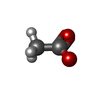[English] 日本語
 Yorodumi
Yorodumi- PDB-1n7v: THE RECEPTOR-BINDING PROTEIN P2 OF BACTERIOPHAGE PRD1: CRYSTAL FO... -
+ Open data
Open data
- Basic information
Basic information
| Entry | Database: PDB / ID: 1n7v | ||||||
|---|---|---|---|---|---|---|---|
| Title | THE RECEPTOR-BINDING PROTEIN P2 OF BACTERIOPHAGE PRD1: CRYSTAL FORM III | ||||||
 Components Components | Adsorption protein P2 | ||||||
 Keywords Keywords | VIRAL PROTEIN / bacteriophage PRD1 / viral receptor-binding / beta-propeller / proline-rich / antibiotic-resistance | ||||||
| Function / homology |  Function and homology information Function and homology informationvirion component / symbiont entry into host cell / virion attachment to host cell Similarity search - Function | ||||||
| Biological species |   Enterobacteria phage PRD1 (virus) Enterobacteria phage PRD1 (virus) | ||||||
| Method |  X-RAY DIFFRACTION / X-RAY DIFFRACTION /  SYNCHROTRON / SYNCHROTRON /  MOLECULAR REPLACEMENT / Resolution: 2.2 Å MOLECULAR REPLACEMENT / Resolution: 2.2 Å | ||||||
 Authors Authors | Xu, L. / Benson, S.D. / Butcher, S.J. / Bamford, D.H. / Burnett, R.M. | ||||||
 Citation Citation |  Journal: Structure / Year: 2003 Journal: Structure / Year: 2003Title: The Receptor Binding Protein P2 of PRD1, a Virus Targeting Antibiotic-Resistant Bacteria, Has a Novel Fold Suggesting Multiple Functions. Authors: Xu, L. / Benson, S.D. / Butcher, S.J. / Bamford, D.H. / Burnett, R.M. #1:  Journal: J.STRUCT.BIOL. / Year: 2000 Journal: J.STRUCT.BIOL. / Year: 2000Title: Crystallization and preliminary X-ray analysis of receptor-binding protein P2 of bacteriopahge PRD1 Authors: Xu, L. / Butcher, S.J. / Benson, S.D. / Bamford, D.H. / Burnett, R.M. #2:  Journal: J.BACTERIOL. / Year: 1999 Journal: J.BACTERIOL. / Year: 1999Title: Stable packing of phage PRD1 DNA requires adsorption protein P2, which binds to the IncP plasmid-encoded conjugative transfer complex Authors: Grahn, A.M. / Caldentey, J. / Bamford, J.K.H. / Bamford, D.H. #3:  Journal: Adv.Virus Res. / Year: 1995 Journal: Adv.Virus Res. / Year: 1995Title: Bacteriophage PRD1: a broad host range dsDNA tectivirus with an internal membrane Authors: Bamford, D.H. / Caldentey, J. / Bamford, J.K.H. #4:  Journal: Cell(Cambridge,Mass.) / Year: 1999 Journal: Cell(Cambridge,Mass.) / Year: 1999Title: Viral evolution revealed by bacteriophage PRD1 and human adenovirus coat protein structures Authors: Benson, S.D. / Bamford, J.K.H. / Bamford, D.H. / Burnett, R.M. #5:  Journal: J.Mol.Biol. / Year: 1999 Journal: J.Mol.Biol. / Year: 1999Title: Bacteriophage PRD1 contains a labile receptor-binding structure at each vertex Authors: Rydman, P.S. / Caldentey, J. / Butcher, S.J. / Fuller, S.D. / Rutten, T. / Bamford, D.H. #6:  Journal: Thesis / Year: 2002 Journal: Thesis / Year: 2002Title: A tale of two viruses with therapeutic potential: Structural studies on CELO, an avian adenovirus and the bacteriophage PRD1 Authors: Xu, L. | ||||||
| History |
| ||||||
| Remark 351 | The biomolecule is most probably a monomer. Nevertheless, it is notable that the same dimer ... The biomolecule is most probably a monomer. Nevertheless, it is notable that the same dimer appears in the two crystal forms (1N7U and 1N7V). Although the buried surface per subunit in the dimer is ~1,206 A**2, which is relatively substantial, it only represents ~5.5% of the surface area of the P2 monomer. Rate zonal centrifugation, gel filtration, cross-linking, sedimentation equilibrium and low angle X-ray scattering strongly suggest that P2 is a monomer in solution. Furthermore, dynamic light scattering measurements indicated a monodisperse solution with an apparent molecular weight of 79 kDa, which is in reasonable agreement with that for the monomer (63.9 kDa). Nevertheless, P2 may form a loosely associated dimer when bound to the virion. |
- Structure visualization
Structure visualization
| Structure viewer | Molecule:  Molmil Molmil Jmol/JSmol Jmol/JSmol |
|---|
- Downloads & links
Downloads & links
- Download
Download
| PDBx/mmCIF format |  1n7v.cif.gz 1n7v.cif.gz | 122.1 KB | Display |  PDBx/mmCIF format PDBx/mmCIF format |
|---|---|---|---|---|
| PDB format |  pdb1n7v.ent.gz pdb1n7v.ent.gz | 92.3 KB | Display |  PDB format PDB format |
| PDBx/mmJSON format |  1n7v.json.gz 1n7v.json.gz | Tree view |  PDBx/mmJSON format PDBx/mmJSON format | |
| Others |  Other downloads Other downloads |
-Validation report
| Arichive directory |  https://data.pdbj.org/pub/pdb/validation_reports/n7/1n7v https://data.pdbj.org/pub/pdb/validation_reports/n7/1n7v ftp://data.pdbj.org/pub/pdb/validation_reports/n7/1n7v ftp://data.pdbj.org/pub/pdb/validation_reports/n7/1n7v | HTTPS FTP |
|---|
-Related structure data
| Related structure data |  1n7uSC S: Starting model for refinement C: citing same article ( |
|---|---|
| Similar structure data |
- Links
Links
- Assembly
Assembly
| Deposited unit | 
| ||||||||
|---|---|---|---|---|---|---|---|---|---|
| 1 | 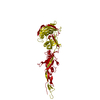
| ||||||||
| Unit cell |
| ||||||||
| Details | Biochemical evidence (gel filtration, low angle X-ray scattering, rate-zonal ultracentrifugation, and dynamic light scattering) indicate that P2 is monomeric, but a potential dimer appears in 3 crystal with different space groups and is obtained for this crystal form by the following symmetry operation: -x, y, -z+1/2 |
- Components
Components
| #1: Protein | Mass: 59925.414 Da / Num. of mol.: 1 Source method: isolated from a genetically manipulated source Source: (gene. exp.)   Enterobacteria phage PRD1 (virus) / Genus: Tectivirus / Gene: II / Plasmid: pMG59 / Production host: Enterobacteria phage PRD1 (virus) / Genus: Tectivirus / Gene: II / Plasmid: pMG59 / Production host:  | ||||
|---|---|---|---|---|---|
| #2: Chemical | | #3: Chemical | ChemComp-CA / | #4: Water | ChemComp-HOH / | |
-Experimental details
-Experiment
| Experiment | Method:  X-RAY DIFFRACTION / Number of used crystals: 1 X-RAY DIFFRACTION / Number of used crystals: 1 |
|---|
- Sample preparation
Sample preparation
| Crystal | Density Matthews: 3.38 Å3/Da / Density % sol: 63.4 % | ||||||||||||||||||||||||||||
|---|---|---|---|---|---|---|---|---|---|---|---|---|---|---|---|---|---|---|---|---|---|---|---|---|---|---|---|---|---|
| Crystal grow | Temperature: 277 K / Method: vapor diffusion, hanging drop, macroseeding / pH: 5 Details: 50% MPD, 0.1 M sodium acetate at pH 5.0, 10 mM CaCl2, VAPOR DIFFUSION, HANGING DROP, MACROSEEDING, temperature 277K | ||||||||||||||||||||||||||||
| Crystal grow | *PLUS Temperature: 4 ℃ / Method: vapor diffusion, hanging drop / Details: used macroseeding | ||||||||||||||||||||||||||||
| Components of the solutions | *PLUS
|
-Data collection
| Diffraction | Mean temperature: 100 K |
|---|---|
| Diffraction source | Source:  SYNCHROTRON / Site: SYNCHROTRON / Site:  NSLS NSLS  / Beamline: X12C / Wavelength: 0.95 Å / Beamline: X12C / Wavelength: 0.95 Å |
| Detector | Type: BRANDEIS / Detector: CCD / Date: Jan 1, 2000 / Details: Mirrors |
| Radiation | Monochromator: double-crystal monochromator si(111), beam focused by a toroidal mirror Protocol: SINGLE WAVELENGTH / Monochromatic (M) / Laue (L): M / Scattering type: x-ray |
| Radiation wavelength | Wavelength: 0.95 Å / Relative weight: 1 |
| Reflection | Resolution: 2.2→38 Å / Num. all: 44325 / Num. obs: 38750 / % possible obs: 87.4 % / Observed criterion σ(F): 1 / Observed criterion σ(I): 1 / Redundancy: 9.6 % / Biso Wilson estimate: 17.2 Å2 / Rsym value: 0.064 / Net I/σ(I): 16.5 |
| Reflection shell | Resolution: 2.2→2.34 Å / Num. unique all: 3312 / Rsym value: 0.771 / % possible all: 45.1 |
| Reflection | *PLUS Rmerge(I) obs: 0.064 |
| Reflection shell | *PLUS % possible obs: 58.7 % / Rmerge(I) obs: 0.771 / Mean I/σ(I) obs: 1.4 |
- Processing
Processing
| Software |
| ||||||||||||||||||||||||||||||||||||||||||||||||||||||||||||||||||||||||||||||||
|---|---|---|---|---|---|---|---|---|---|---|---|---|---|---|---|---|---|---|---|---|---|---|---|---|---|---|---|---|---|---|---|---|---|---|---|---|---|---|---|---|---|---|---|---|---|---|---|---|---|---|---|---|---|---|---|---|---|---|---|---|---|---|---|---|---|---|---|---|---|---|---|---|---|---|---|---|---|---|---|---|---|
| Refinement | Method to determine structure:  MOLECULAR REPLACEMENT MOLECULAR REPLACEMENTStarting model: P2 Crystal Form I(1N7U) Resolution: 2.2→38.11 Å / Rfactor Rfree error: 0.006 / Isotropic thermal model: RESTRAINED / Cross valid method: THROUGHOUT / σ(F): 0 / Stereochemistry target values: Engh & Huber
| ||||||||||||||||||||||||||||||||||||||||||||||||||||||||||||||||||||||||||||||||
| Solvent computation | Solvent model: FLAT MODEL / Bsol: 47.6661 Å2 / ksol: 0.319657 e/Å3 | ||||||||||||||||||||||||||||||||||||||||||||||||||||||||||||||||||||||||||||||||
| Displacement parameters | Biso mean: 40.5 Å2
| ||||||||||||||||||||||||||||||||||||||||||||||||||||||||||||||||||||||||||||||||
| Refine analyze | Luzzati coordinate error free: 0.38 Å / Luzzati sigma a free: 0.51 Å | ||||||||||||||||||||||||||||||||||||||||||||||||||||||||||||||||||||||||||||||||
| Refinement step | Cycle: LAST / Resolution: 2.2→38.11 Å
| ||||||||||||||||||||||||||||||||||||||||||||||||||||||||||||||||||||||||||||||||
| Refine LS restraints |
| ||||||||||||||||||||||||||||||||||||||||||||||||||||||||||||||||||||||||||||||||
| LS refinement shell | Resolution: 2.2→2.34 Å / Rfactor Rfree error: 0.033 / Total num. of bins used: 6
| ||||||||||||||||||||||||||||||||||||||||||||||||||||||||||||||||||||||||||||||||
| Xplor file |
| ||||||||||||||||||||||||||||||||||||||||||||||||||||||||||||||||||||||||||||||||
| Refinement | *PLUS Highest resolution: 2.2 Å / Rfactor Rfree: 0.228 / Rfactor Rwork: 0.262 | ||||||||||||||||||||||||||||||||||||||||||||||||||||||||||||||||||||||||||||||||
| Solvent computation | *PLUS | ||||||||||||||||||||||||||||||||||||||||||||||||||||||||||||||||||||||||||||||||
| Displacement parameters | *PLUS | ||||||||||||||||||||||||||||||||||||||||||||||||||||||||||||||||||||||||||||||||
| Refine LS restraints | *PLUS
|
 Movie
Movie Controller
Controller


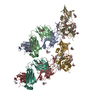

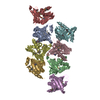
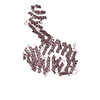
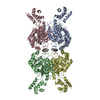
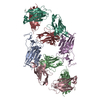
 PDBj
PDBj